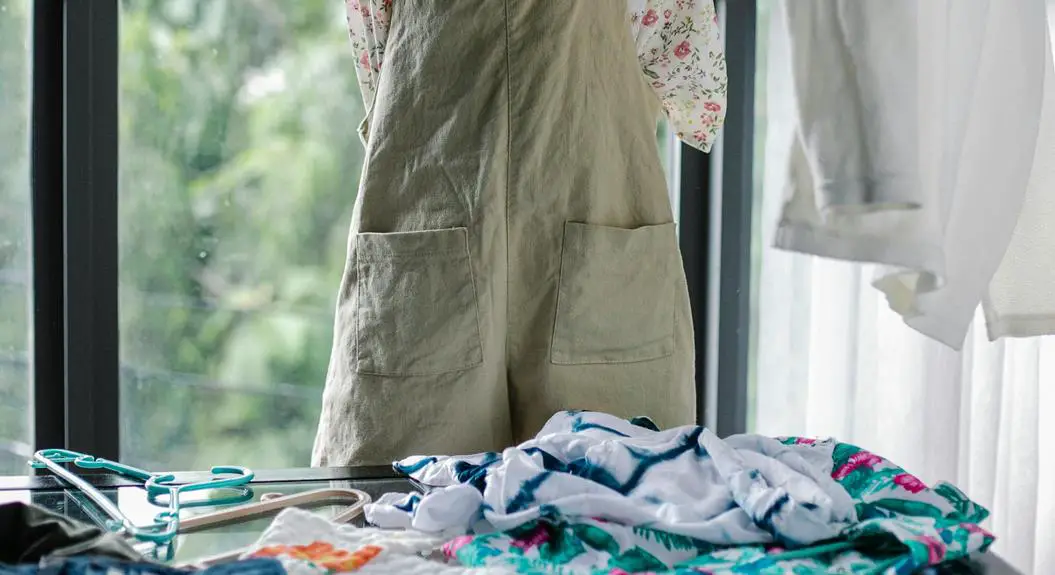When you want to achieve a crisp look with stiffened fabric, it all starts with the right choices. You'll need to select suitable materials like cotton or linen and decide on an effective stiffening agent, whether that's spray starch or fusible interfacing. But getting that polished finish requires more than just good materials; preparation is key. As you consider the steps involved, you'll find that attention to detail makes all the difference. So, what are the specific techniques that can help you master this craft?
Table of Contents
Key Takeaways
- Choose the right fabric, such as cotton or linen, that holds shapes well for a crisp appearance.
- Use appropriate stiffening agents like spray starch or fusible interfacing to enhance fabric structure.
- Prepare the fabric by cleaning, ironing, and cutting accurately to ensure a smooth surface before stiffening.
- Allow fabric to dry completely using air drying or low heat ironing to maintain stiffness and prevent wrinkles.
Understanding Stiffened Fabric
Stiffened fabric is a versatile material that can give your projects a structured and polished appearance. This type of fabric is created by applying a stiffening agent, such as starch, resin, or interfacing, to regular fabric, enhancing its body and ability to hold shapes.
When you choose to work with stiffened fabric, you're opening up a world of creative possibilities, from home decor to fashion accessories.
Understanding the properties of stiffened fabric is crucial for achieving the desired effect in your projects. It's typically lightweight yet firm, providing support without weighing down your creations.
You'll find that it can be easily manipulated, allowing you to create crisp edges, defined shapes, and tailored looks. The stiffness can vary based on the type of fabric and stiffening agent used, so you'll want to experiment to find the right balance for your needs.
When you use stiffened fabric, consider how it interacts with other materials. Its structured nature can elevate the design, but be mindful of how it drapes and behaves when combined with softer fabrics. This knowledge will help you create stunning, cohesive projects.
Choosing the Right Materials
When you're choosing materials for stiffened fabric, it's crucial to understand the different fabric types available.
Each fabric can react differently to stiffening agents, so you'll want to compare their properties carefully.
Let's explore how the right combination can help you achieve that crisp look you're after.
Fabric Types Overview
Choosing the right fabric is crucial for achieving that crisp, polished appearance in your projects.
Start by considering cotton, which is known for its versatility and ability to hold shapes well. It's perfect for items like crisp table runners or structured garments.
Linen is another fantastic option; its natural stiffness gives a sophisticated touch and a refined look, ideal for summer wear.
If you're after something more robust, canvas provides a heavy-duty choice. It's great for home decor items like curtains or bags, helping maintain structure over time.
For a touch of elegance, look into silk organza. This lightweight fabric adds a whimsical, airy quality while still holding its form beautifully, making it perfect for overlays or special occasion wear.
Don't overlook synthetic blends, either. Fabrics like polyester can mimic the crispness of cotton or linen while being easier to care for.
Each fabric type has its unique qualities, so think about the final look you want to achieve.
Test swatches before committing, and you'll be well on your way to selecting the ideal materials for a stunning, stiffened finish.
Stiffening Agents Comparison
To achieve that crisp look, you'll want to explore various stiffening agents, each offering unique benefits for different fabric types.
One of the most popular options is spray starch. It's easy to use and works well on cotton and linen, providing a light to medium stiffness. If you're looking for something stronger, try liquid starch. It gives a more pronounced hold, ideal for heavier fabrics like canvas.
For a more permanent solution, consider fusible interfacing. This is perfect for structured garments, as it bonds directly to the fabric when heated, offering excellent support.
If you're working with delicate fabrics, a fabric stiffener made from natural ingredients might be your best bet. These are gentle yet effective, allowing for a crisp finish without compromising the fabric's integrity.
Lastly, PVA (polyvinyl acetate) glue can also serve as a stiffening agent when diluted with water. It dries clear and provides excellent hold, especially for crafts.
Choosing the right stiffening agent depends on your project's specific needs, so experiment to find the best fit for your fabric and desired finish.
Preparing Your Fabric
Before you begin, make sure your fabric is clean and free from any wrinkles or creases. This step is crucial for achieving that crisp look you're aiming for. Start by washing your fabric according to its care instructions. If it's already clean, give it a quick iron to eliminate any stubborn wrinkles.
Next, gather your materials and lay the fabric flat on an ironing board. Use a pressing cloth to protect delicate fibers. Here's a quick reference table to help you visualize the preparation process:
| Step | Action |
|---|---|
| 1. Wash | Clean fabric according to care instructions |
| 2. Iron | Smooth out wrinkles using an iron |
| 3. Lay Flat | Place fabric on a flat surface for cutting |
Ensure your fabric is completely dry before moving on. If you skip this step, you might end up with an uneven stiffening effect later. With your fabric prepped and ready, you're setting the stage for a beautifully crisp finish. Now, you're ready to dive into the fun part: stiffening!
Techniques for Stiffening
With your fabric prepped and smooth, it's time to explore various techniques for stiffening that will help you achieve that desired crisp look.
One popular method is using fabric stiffeners, which you can find in spray or liquid form. Simply mix the liquid with water according to the package instructions, then soak your fabric or spray the stiffener directly onto it.
Another effective technique is using cornstarch. Mix equal parts of cornstarch and water in a pot, bring it to a boil, and stir until it thickens. Allow it to cool slightly, then dip your fabric into the mixture or apply it with a brush.
You might also consider using a mixture of white glue and water. Combine one part glue with two parts water, coat your fabric, and let it dry. This method can create a firmer finish.
Lastly, for a more natural approach, a sugar solution can work wonders. Dissolve sugar in water, apply it to your fabric, and let it dry.
Each technique offers a unique level of stiffness, so feel free to experiment until you find the one that suits your project best!
Drying and Setting Your Fabric
After applying your stiffening technique, drying and setting your fabric properly is essential to achieving that crisp look you want. The drying process can significantly impact the final appearance, so pay attention to how you handle it.
Here are some drying methods to consider:
| Method | Description |
|---|---|
| Air Drying | Lay the fabric flat on a clean surface to dry naturally. This method keeps the stiffness intact without distortion. |
| Hang Drying | Hang your fabric to allow gravity to help set the shape. Ensure it's fully supported to prevent sagging. |
| Ironing (Low Heat) | Use a low heat setting to press the fabric gently. This can help set the stiffness while removing any wrinkles. |
| Heat Setting | If using a heat-activated stiffener, follow the manufacturer's instructions for heat application to lock in the crispness. |
Choose the method that best suits your project and fabric type. Each technique offers unique benefits, so think carefully about how you'd like your finished piece to look. Allow your fabric to dry completely before using it to ensure it maintains that sharp, polished appearance.
Tips for Maintaining Crispness
To keep your stiffened fabric looking crisp, you need to pay attention to how you wash and store it.
Using the right techniques can make a big difference in maintaining that fresh appearance.
Let's explore some effective washing methods and storage tips that'll help you preserve your fabric's crispness.
Proper Washing Techniques
Maintaining your fabric's crispness starts with washing it correctly to prevent unwanted softness. If you want to keep that fresh, starched look, follow these essential washing techniques:
- Use Cold Water: Always wash your stiffened fabric in cold water. Hot water can break down the stiffness and lead to softness.
- Gentle Cycle Only: Set your washing machine to a gentle cycle. This reduces agitation and helps maintain the fabric's integrity.
- Mild Detergent: Choose a mild detergent specifically designed for delicate fabrics. Avoid harsh chemicals that can strip away the stiffness.
- Air Dry: Instead of using a dryer, air dry your fabric. Hang it up or lay it flat to dry, which keeps the fibers firm and prevents any unwanted wrinkles from heat.
Storage Methods Explained
Proper storage plays a vital role in keeping your stiffened fabric looking crisp and fresh. To maintain that sharp appearance, follow these tips:
- Keep it Flat: Always store your stiffened fabric flat to avoid unwanted creases. Use acid-free tissue paper between layers for added protection.
- Avoid Folding: If you must fold, use larger folds rather than small ones, and ensure they're loose. Tight folds can create deep creases that are hard to remove.
- Store in a Cool, Dry Place: Excess humidity can cause your fabric to lose its stiffness. Choose a dry area away from direct sunlight.
- Use a Garment Bag: When storing items like stiffened garments, opt for breathable garment bags. This prevents dust accumulation while allowing air circulation.
- Regular Checks: Periodically check your stored fabric to ensure it remains in good condition.
Here's a quick reference table to summarize:
| Storage Method | Benefits | Tips |
|---|---|---|
| Keep it Flat | Prevents creases | Use acid-free paper |
| Avoid Folding | Maintains crispness | Use larger folds |
| Cool, Dry Place | Reduces humidity | Avoid sunlight |
| Garment Bag | Dust protection | Ensure breathability |
| Regular Checks | Early issue detection | Inspect every few months |
Creative Uses for Stiffened Fabric
Stiffened fabric opens up a world of creative possibilities, allowing you to craft everything from bold home decor to unique accessories. You'll find that it adds structure and intrigue to your projects, making them stand out.
Here are some creative uses for stiffened fabric that you can easily try:
- Wall Art: Create stunning wall hangings by cutting stiffened fabric into shapes and mounting them on canvases. The rigidity adds depth and texture.
- Lampshades: Design custom lampshades by wrapping stiffened fabric around a frame. It allows for unique patterns and light diffusion.
- Bags & Purses: Use stiffened fabric to fashion stylish bags. The added structure helps your creations hold their shape while remaining functional.
- Table Runners: Make eye-catching table runners that keep their form during gatherings. Choose vibrant colors or patterns to elevate your dining experience.
Frequently Asked Questions
Can I Use Any Type of Fabric for Stiffening?
You can use various fabrics for stiffening, but lightweight cotton, linen, or canvas work best. Avoid stretchy materials, as they won't hold their shape well. Experiment to find the right fabric for your project.
How Long Does the Stiffening Process Take?
The stiffening process can take anywhere from a few minutes to several hours, depending on the method you choose. You'll want to follow the instructions carefully to achieve the best results for your project.
Can I Wash Stiffened Fabric Afterward?
Yes, you can wash stiffened fabric, but it's best to check the care instructions first. Washing may affect the stiffness, so consider spot cleaning instead to maintain that crisp appearance you're aiming for.
Is There a Way to Soften Stiffened Fabric?
Yes, you can soften stiffened fabric. Try soaking it in warm water with a mild detergent, then gently knead and rinse. Alternatively, you can steam it lightly to relax the stiffness without damaging the material.
What Tools Do I Need for Stiffening Fabric?
To stiffen fabric, you'll need a few tools: a spray bottle for applying stiffening solution, a brush for even coverage, and a flat surface or board to lay the fabric while it dries.
- The Difference Between Gabardine and Denim Fabric - June 24, 2025
- Why Every Man Needs a Pair of Wool Gabardine Dress Pants - June 24, 2025
- Exploring Burberry’s Tropical Gabardine for Lighter Outerwear - June 24, 2025







